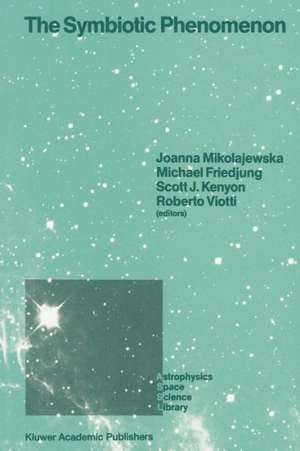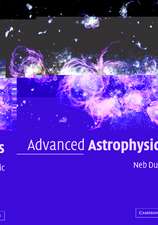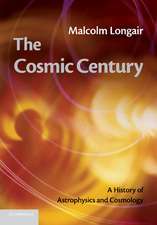The Symbiotic Phenomenon: Proceedings of the 103rd Colloquium of the International Astronomical Union, Held in Torun, Poland, August 18–20, 1987: Astrophysics and Space Science Library, cartea 145
Editat de Joanna Mikolajewska, M. Friedjung, Scott J. Kenyon, Roberto Viottien Limba Engleză Paperback – 9 noi 2011
Din seria Astrophysics and Space Science Library
- 24%
 Preț: 799.10 lei
Preț: 799.10 lei - 15%
 Preț: 647.92 lei
Preț: 647.92 lei - 18%
 Preț: 983.81 lei
Preț: 983.81 lei - 18%
 Preț: 790.28 lei
Preț: 790.28 lei -
 Preț: 359.86 lei
Preț: 359.86 lei -
 Preț: 389.71 lei
Preț: 389.71 lei - 20%
 Preț: 691.14 lei
Preț: 691.14 lei - 20%
 Preț: 816.18 lei
Preț: 816.18 lei - 18%
 Preț: 1011.27 lei
Preț: 1011.27 lei -
 Preț: 402.56 lei
Preț: 402.56 lei - 15%
 Preț: 664.93 lei
Preț: 664.93 lei -
 Preț: 398.15 lei
Preț: 398.15 lei - 18%
 Preț: 954.77 lei
Preț: 954.77 lei -
 Preț: 411.04 lei
Preț: 411.04 lei - 18%
 Preț: 1225.31 lei
Preț: 1225.31 lei - 18%
 Preț: 1843.29 lei
Preț: 1843.29 lei -
 Preț: 393.13 lei
Preț: 393.13 lei -
 Preț: 400.26 lei
Preț: 400.26 lei - 18%
 Preț: 953.82 lei
Preț: 953.82 lei - 18%
 Preț: 960.61 lei
Preț: 960.61 lei -
 Preț: 398.35 lei
Preț: 398.35 lei -
 Preț: 390.84 lei
Preț: 390.84 lei -
 Preț: 413.76 lei
Preț: 413.76 lei -
 Preț: 416.64 lei
Preț: 416.64 lei - 18%
 Preț: 947.67 lei
Preț: 947.67 lei -
 Preț: 404.51 lei
Preț: 404.51 lei - 18%
 Preț: 956.50 lei
Preț: 956.50 lei -
 Preț: 403.75 lei
Preț: 403.75 lei - 18%
 Preț: 1229.40 lei
Preț: 1229.40 lei - 18%
 Preț: 1224.99 lei
Preț: 1224.99 lei -
 Preț: 404.29 lei
Preț: 404.29 lei - 15%
 Preț: 654.77 lei
Preț: 654.77 lei - 18%
 Preț: 1248.20 lei
Preț: 1248.20 lei - 18%
 Preț: 955.25 lei
Preț: 955.25 lei - 18%
 Preț: 1846.28 lei
Preț: 1846.28 lei - 18%
 Preț: 1233.06 lei
Preț: 1233.06 lei - 18%
 Preț: 1234.77 lei
Preț: 1234.77 lei
Preț: 393.13 lei
Nou
Puncte Express: 590
Preț estimativ în valută:
75.25€ • 81.76$ • 63.25£
75.25€ • 81.76$ • 63.25£
Carte tipărită la comandă
Livrare economică 21 aprilie-05 mai
Preluare comenzi: 021 569.72.76
Specificații
ISBN-13: 9789401078337
ISBN-10: 9401078335
Pagini: 384
Ilustrații: 380 p.
Dimensiuni: 155 x 235 x 20 mm
Greutate: 0.54 kg
Ediția:Softcover reprint of the original 1st ed. 1988
Editura: SPRINGER NETHERLANDS
Colecția Springer
Seria Astrophysics and Space Science Library
Locul publicării:Dordrecht, Netherlands
ISBN-10: 9401078335
Pagini: 384
Ilustrații: 380 p.
Dimensiuni: 155 x 235 x 20 mm
Greutate: 0.54 kg
Ediția:Softcover reprint of the original 1st ed. 1988
Editura: SPRINGER NETHERLANDS
Colecția Springer
Seria Astrophysics and Space Science Library
Locul publicării:Dordrecht, Netherlands
Public țintă
ResearchCuprins
Session 1. The Basic Data.- A Perspective on the Symbiotic Stars.- Multifrequency Observations of Symbiotic Stars.- V 641 Cas — A Symbiotic Candidate?.- Ultraviolet FeII Absorption Lines in HD 59643.- Orbital Radial Velocity Curves of Symbiotic Stars.- Orbital Parameters of Three Symbiotic Stars.- Properties of Cool Stellar Components in S-Type Symbiotic Stars.- Absolute Energy Distributions for Selected Quiescent Symbiotic Stars.- Infrared Observations of Symbiotic Miras.- The Environments of Cool Stars.- Dust Emission from Symbiotic Stars: Interpretation of IRAS Observations.- Atmospheric Shocks in Mira Variables — MgII Emission.- The Radio Properties of Symbiotic Stars.- Radio Imaging of Symbiotic Stars.- Observations of Bipolar Mass Flow from Symbiotic Stars.- Optical Polarimetry of Symbiotic Stars.- Polarimetry of Symbiotic Stars.- The Present State of Symbiotic Polarimetry.- Session 2. The Physics of the Symbiotic Phenomenon.- Ionization Models of Symbiotic Stars.- Photoionization Models with Accretion Disks.- Emission Line Ratio Classification of Symbiotic Stars.- Resonance Line Profiles from Radial Accretion Flows.- Colliding Winds in Symbiotic Systems.- Accretion Disks in Symbiotic Stars.- Accretion from Stellar Winds.- Thermonuclear Runaway Models for Symbiotic Novae.- On the Outburst of Symbiotic Stars.- Thermonuclear Runaways on Accreting Hot White Dwarfs.- The Decay Time after a Thermonuclear Flash.- General Discussion on the Physics of Symbiotic Stars.- Session 3. Physics of Individual Objects.- Z Andromedae: Quiescence and Activity.- CI Cygni — The Well Understood Symbiotic Binary?.- A P Cygni Profile for the He 10830 A Line of CI Cyg in Eclipse.- Symbiotic Eclipsing Binary Star CI Cyg. The Cold Component Variability.- AG Dra a Symbiotic Star withan Uncommon Cool Component.- Spectral Variations of AG Dra between 1981 and 1985.- CH Cyg: Ten Years of Activity.- CH Cygni Half a Century Ago — Changing Activity of the Cool Component.- Spectroscopic Orbit of the Eclipsing Symbiotic Star CH Cyg.- Slow and Rapid Changes of the Radial Velocities in the Symbiotic Binary CH Cygni.- Radial Velocities of CH Cyg Just as the Jets Appeared.- The Spectrum of CH Cygni — A Search for Rapid Line Variations.- Polarization in CH Cygni during Quiet and Active Phases.- Continued Radio Activity from CH Cygni.- An “Accretor-Propeller” Model of CH Cygni.- A Review of the R Aquarii System.- The Ultraviolet Spectrum of RX Puppis.- A Model for RX Puppis.- Symbiotic Star AG Pegasi — Retrospect and Prospects.- The Observations of AG Peg during 1985-1987.- The Photometric Period of AG Pegasi.- The Causes of the Light Variations in AG Peg.- Ultraviolet Variability of the Symbiotic Star AG Peg.- A New Absorption-Line Orbit for the Symbiotic Nova AG Pegasi.- The Symbiotic Novae.- The Symbiotic Nova PU Vul (Kuwano-Honda Object): Some Results of Coordinated Investigations.- The Spectroscopic Variations of the Symbiotic Nova PU Vul.- Emission Line Analyses of HBV 475, V1016 Cyg and HM Sge.- Session 4. Contributions for Other Individual Objects.- Photometric and Spectroscopic Variations of the Symbiotic Star EG Andromedae.- The Search for the Elusive Companion of EG Andromedae.- The Symbiotic Star UV Aurigae.- The Third Galactic Carbon Symbiotic.- BI Crucis.- Effects of Eccentric Orbit of BF Cygni on IUE and Optical Spectra.- Ultraviolet to Near Infrared Observations of BF Cyg.- Ultraviolet Variability of AX Persei.- IUE and Optical Observations of He 2-104.- Summary of Discussion on Individual Objects.- Session 5. Symbiotic Phenomena andStellar Evolution Conclusions.- The Formation and Evolution of Symbiotic Stars.- Recurrent Novae.- Unravelling the Multiple Component Radio Emission of RS Oph in Outburst.- The 1987 Outburst of the Recurrent Nova U Sco.- What Can We Learn from ? Aur Binary Systems?.- Summary of Final Discussion.- Concluding Remarks.- Overheard in Torun.- Object Index.













